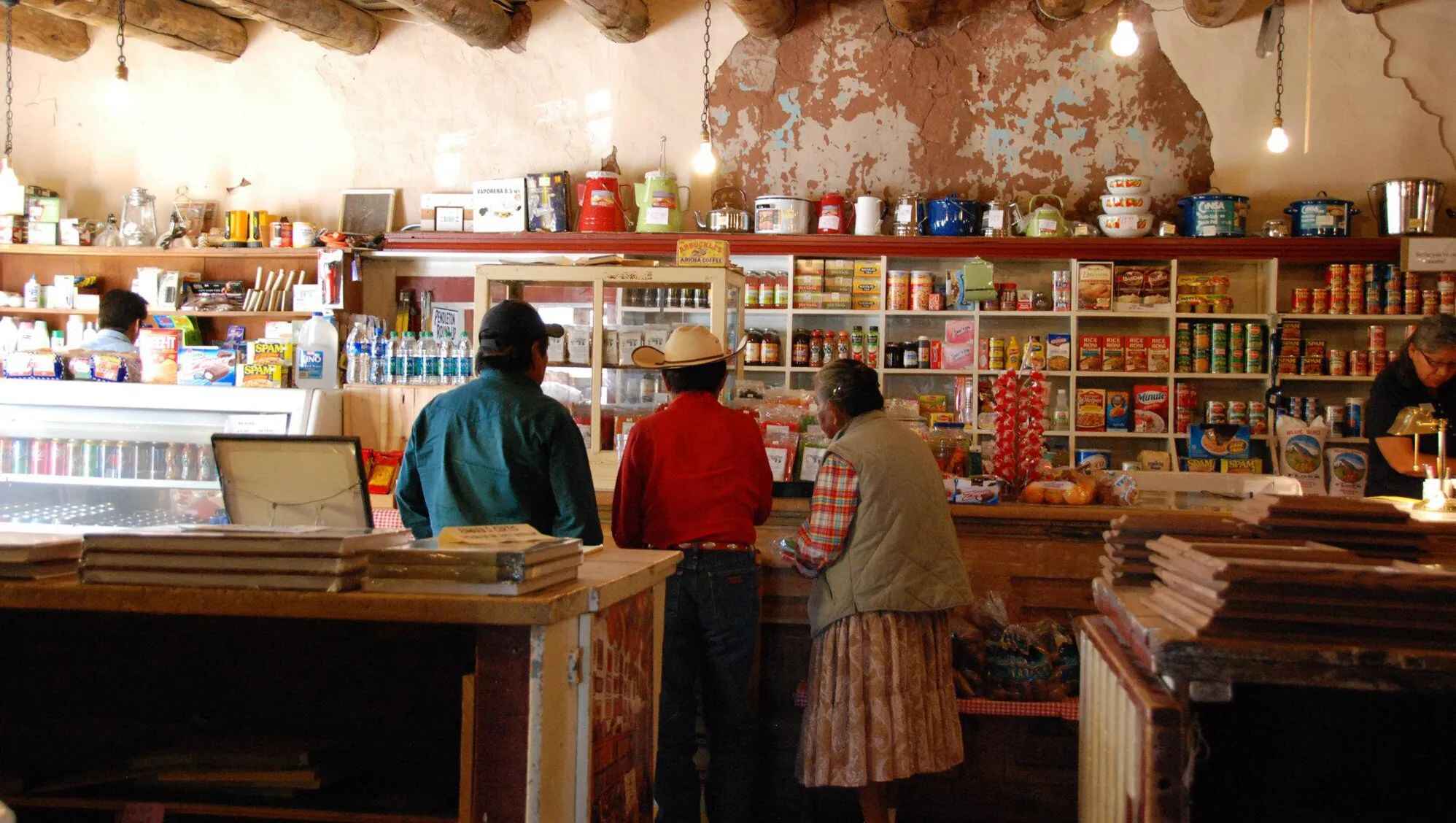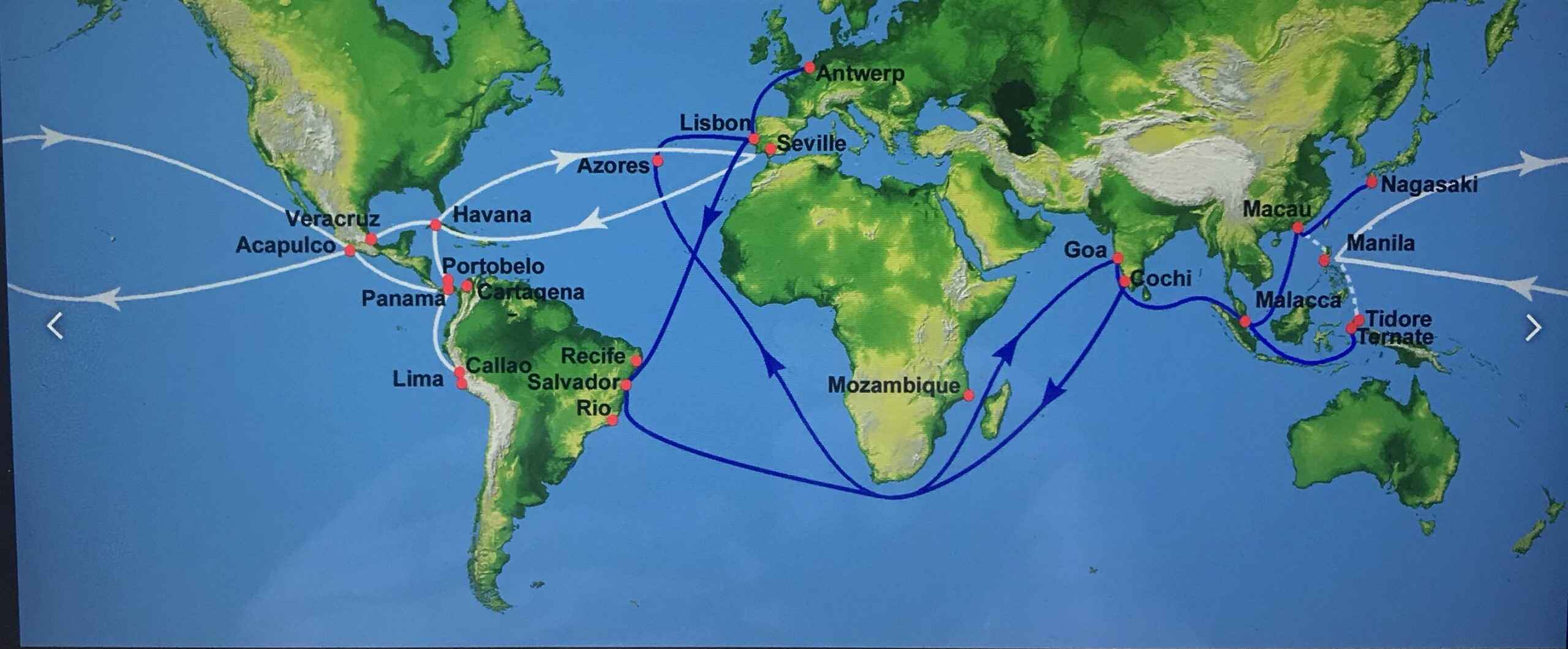Introduction
A trading post is a historical establishment that played a crucial role in facilitating trade and commerce in various regions around the world. It served as a hub where merchants and traders gathered to exchange goods, establish business relationships, and contribute to economic development. These trading posts were instrumental in connecting different cultures, enabling the exchange of goods, ideas, and knowledge.
The concept of trading posts dates back to ancient times, with evidence of their existence found in civilizations such as Ancient Mesopotamia, Egypt, and China. Over the centuries, trading posts evolved in form and function, adapting to the changing dynamics of the global trade landscape.
Trading posts were situated in strategic locations, such as ports, riverbanks, or along trade routes, making them easily accessible to merchants and traders. They offered a range of goods, from local produce and crafts to exotic spices, fabrics, and precious metals. These trading posts became meeting points for individuals from different cultures and backgrounds, fostering cultural exchange and shaping the development of societies.
The purpose of trading posts was not limited to the exchange of goods. They also played a vital role in fostering relationships between individuals and communities, establishing networks, and facilitating the flow of information. Merchants would often gather at these posts to share news, market trends, and updates on political developments, creating a vibrant and dynamic business environment.
Throughout history, trading posts acted as catalysts for economic growth and development. They stimulated local economies, encouraging the production of goods for trade and providing employment opportunities for individuals. Additionally, they served as important sources of revenue for the ruling powers, who often imposed taxes and levies on the goods passing through these posts.
Today, despite the evolution of global trade and the rise of modern technologies, the concept of trading posts still holds significance. While many traditional trading posts have transformed into bustling cities or commercial centers, the principles and functions they embodied continue to shape the modern-day business landscape.
In the following sections, we will delve deeper into the definition, history, and functions of trading posts, exploring their role in economic development and their significance in the contemporary world.
Definition of a Trading Post
A trading post can be defined as a physical establishment or a designated location where merchants, traders, and indigenous communities gather to engage in commercial activities. It serves as a hub for the exchange of goods, ideas, and cultures, fostering economic growth and creating opportunities for business relationships.
Traditionally, trading posts were found in strategic locations along trade routes, ports, or areas with abundant natural resources. They provided a central place for merchants to sell and trade their goods, attracting both local and foreign traders. These posts were often managed by a governing body or local authorities to regulate trade activities, ensure fair practices, and collect taxes or tariffs.
Trading posts can take various forms depending on the context and time in history. In early civilizations, they were simple structures or temporary camps where traders would set up stalls or marketplaces. As trade networks and routes expanded, trading posts became more permanent, evolving into fortified structures or settlements equipped with storage facilities, accommodation for traders, and sometimes military defenses.
One defining characteristic of a trading post is its function as a meeting point for different cultures and communities. It serves as a space for cultural exchange, where people from diverse backgrounds interact, learn from each other, and develop mutual understanding. This cross-cultural interaction contributes to the enrichment of ideas, practices, and traditions.
Historically, trading posts have been crucial for the establishment of global trade networks. They facilitated the exchange of a wide range of goods including agricultural products, textiles, spices, precious metals, and luxury items. The availability of such goods at trading posts attracted traders from distant regions, creating opportunities for trade and contributing to the growth and development of economies.
It is important to note that today, the concept of a trading post has evolved beyond physical structures. With the advancement of technology, trading posts have also transitioned to online platforms and digital marketplaces. These virtual trading posts provide a platform for global commerce, connecting buyers and sellers from different parts of the world.
Historical Background of Trading Posts
The origins of trading posts can be traced back to ancient civilizations where trade played a pivotal role in the development of societies. In Mesopotamia, one of the earliest known trading posts was established in the city of Ur around 2000 BCE. Located near the mouth of the Euphrates River, Ur became a thriving hub for commerce, attracting merchants from neighboring regions.
As civilizations expanded and trade networks grew, trading posts became more prevalent. In Ancient Egypt, for example, the city of Thebes served as a vital trading post along the Nile River, connecting the Mediterranean region with the heart of Africa. Thebes became a major center for trade in luxury goods, such as gold, ivory, and exotic spices.
In China, trading posts emerged along the ancient Silk Road, a network of trade routes connecting Asia, Europe, and Africa. Cities like Xi’an and Dunhuang flourished as trading hubs, facilitating the exchange of silk, porcelain, spices, and other valuable commodities.
During the Age of Exploration, European powers established trading posts around the world as they expanded their colonial empires. The Portuguese were pioneers in this regard, setting up trading posts in strategic locations such as Goa in India and Macau in China to control the lucrative spice trade. The Dutch, English, French, and Spanish followed suit, establishing their own network of trading posts in Africa, Asia, and the Americas.
These European trading posts played a significant role in the development of global trade. They not only served as centers for the exchange of goods but also facilitated the diffusion of cultural influences. The merchants and explorers who frequented these trading posts brought back new ideas, technologies, and products to their home countries, leading to significant advancements in various fields.
As trade routes changed and new sea routes were discovered, the importance of trading posts shifted. Ports such as Istanbul (formerly Constantinople) and Venice became prominent as the gateway between East and West, serving as significant trading posts during the medieval period.
In North America, trading posts played a crucial role in the fur trade industry during the colonization period. European traders established posts in regions abundant in fur-bearing animals, such as the Hudson Bay Company’s posts in present-day Canada and the American Fur Company’s posts in the western United States.
Throughout history, trading posts served as catalysts for economic growth, cultural exchange, and the establishment of global trade networks. They played a crucial role in shaping the world we live in today, fostering connections between different civilizations and paving the way for modern commerce.
Purpose of Trading Posts
The primary purpose of trading posts was to facilitate trade and commerce between different regions and cultures. These establishments served as central hubs where merchants, traders, and indigenous communities could come together to exchange goods, establish business relationships, and contribute to economic growth.
One of the main purposes of trading posts was to provide a convenient and secure location for trade activities. They were strategically situated along trade routes, ports, or areas with valuable resources, making them easily accessible to traders and merchants. The centralized nature of trading posts allowed for efficient exchange, reducing the need for traders to travel long distances to conduct business.
In addition to facilitating trade, trading posts also served as meeting points for individuals from diverse backgrounds. Merchants and traders from different cultures and regions would gather at these posts, fostering cultural exchange and creating opportunities for learning and understanding. The interaction and dialogue among traders at the trading posts contributed to the diffusion of ideas, practices, and technologies.
Another purpose of trading posts was to provide a platform for the exchange of a wide variety of goods. Depending on the location and the available resources, trading posts offered a range of products, from local agricultural produce to exotic spices, textiles, and precious metals. The diverse selection of goods available at these posts attracted traders from different regions, leading to an expansion of trade networks and the growth of local economies.
Furthermore, trading posts played a role in establishing and maintaining business relationships. They provided a space where traders could build trust, negotiate deals, and establish long-term partnerships. The regular gatherings at trading posts allowed traders to stay updated on market trends, share information, and connect with potential business associates.
Additionally, trading posts served as centers for economic activities in their respective regions. They stimulated local economies by creating employment opportunities, promoting the production of goods for trade, and generating revenue for the ruling powers. Taxes and levies imposed on the goods passing through these posts provided a source of income for the governing authorities, contributing to their economic stability.
Overall, the purpose of trading posts can be summarized as providing a platform for trade, cultural exchange, and relationship-building. These establishments played a vital role in connecting different regions, fostering economic growth, and shaping the history and development of societies around the world.
Goods Traded at a Trading Post
Trading posts were known for offering a diverse array of goods that catered to the demands of local communities and attracted traders from afar. The availability of such goods at trading posts played a crucial role in facilitating trade and contributing to the economic growth of regions. Here are some of the common types of goods traded at trading posts throughout history:
1. Agricultural Products: Trading posts were often located in regions with fertile lands and abundant agricultural resources. As such, they were hubs for trading agricultural products such as grains, fruits, vegetables, and livestock. These goods were essential for sustenance as well as for trade between communities.
2. Exotic Spices and Herbs: One of the most sought-after goods at trading posts were exotic spices and herbs. The spice trade played a significant role in shaping the course of history, and trading posts acted as central locations for the exchange of spices like pepper, cinnamon, cloves, and nutmeg. These precious commodities were highly valued for their culinary, medicinal, and aromatic properties.
3. Textiles and Fabrics: The trading of textiles and fabrics was a significant part of the exchange at trading posts. Different regions had their unique textile traditions, and trading posts served as places where these textile goods could be obtained and traded. Silk, cotton, wool, and other fabrics were highly sought after and played a crucial role in regional and global trade.
4. Precious Metals and Gemstones: Gold, silver, and gemstones were highly valued commodities traded at trading posts. These precious metals and gemstones were used as currency, symbols of wealth, and materials for crafting jewelry and decorative items. Trading posts provided a platform for the exchange of these valuable resources, attracting merchants and traders seeking to obtain or sell them.
5. Luxury Goods: Trading posts were known for offering an array of luxury goods that appealed to the affluent and elite class. These goods included fine pottery, ceramics, intricately carved sculptures, handcrafted furniture, and other prestigious items. The availability of such luxury goods at trading posts added to their allure and attracted a discerning clientele.
6. Tools, Weapons, and Implements: Trading posts also facilitated the exchange of tools, weapons, and implements that were essential for various purposes. This included tools for farming and craftsmanship, weapons for defense and hunting, and implements for everyday tasks. The trading of these goods contributed to the development and advancement of different industries and trades.
7. Cultural Artifacts: Trading posts were not only centers for the exchange of material goods but also played a role in the trading of cultural artifacts. These included traditional artwork, artifacts, religious objects, and items of historical significance. The trading of cultural artifacts at trading posts contributed to the preservation and dissemination of cultural heritage.
These are just a few examples of the wide range of goods that were traded at trading posts throughout history. The trading of such goods not only fueled economic development but also fostered cultural exchange, contributed to technological advancements, and shaped the course of civilizations.
Function of a Trading Post
The function of a trading post extends beyond being a mere hub for trade. These establishments served various purposes that contributed to the development of regional economies and the facilitation of cultural exchange. Here are some of the key functions of a trading post:
1. Trade Facilitation: The primary function of a trading post is to facilitate the exchange of goods between merchants, traders, and local communities. It provides a centralized location where buyers and sellers can come together, negotiate deals, and conduct trade transactions in a secure and regulated environment.
2. Cultural Exchange: Trading posts acted as meeting points for individuals from diverse backgrounds, fostering cultural exchange and mutual understanding. Merchants and traders brought not only goods but also their various cultural practices, traditions, and languages to the trading posts, creating a vibrant melting pot of ideas and influences.
3. Information Exchange: Trading posts were not just about trading goods; they also served as informational hubs. Merchants gathered at these posts to share news, market trends, and updates on political developments. This exchange of information enabled traders to make informed decisions, adapt to changing market conditions, and expand their business networks.
4. Economic Stimulation: Trading posts played a crucial role in stimulating local economies. They provided employment opportunities for individuals working at the posts, such as porters, guides, interpreters, and craftsmen. Moreover, the trade activities at trading posts encouraged the production of goods for trade, benefiting local producers and stimulating economic growth.
5. Regulation and Fair Trade: Trading posts were often regulated by governing bodies or local authorities to ensure fair trade practices and maintain order. This regulation included setting standards for quality, monitoring prices, resolving disputes, and collecting taxes or levies on traded goods. The presence of these regulations helped establish trust and maintain fairness in trade transactions.
6. Entrepreneurship and Innovation: Trading posts provided opportunities for entrepreneurship and innovation. Individuals with entrepreneurial aspirations could set up their own businesses and pursue trading ventures. The competition and interaction with other traders at the posts often led to innovation in business practices, product development, and marketing strategies.
7. Networking and Relationship Building: The gathering of traders at trading posts facilitated networking and the establishment of business relationships. Traders built trust, negotiated deals, and formed partnerships that often extended beyond their immediate trading transactions. These relationships formed the foundation for long-term business collaborations and contributed to the growth and stability of trade networks.
8. Cross-Cultural Understanding: Trading posts played a crucial role in fostering cross-cultural understanding and tolerance. The exchange of goods, ideas, and practices between traders and communities from different cultures led to the sharing of knowledge and experiences. This cross-cultural understanding helped break down barriers, promote tolerance, and enrich societies with diverse perspectives.
The function of a trading post went beyond being a hub for trade; it was a dynamic and multi-faceted institution that contributed to economic growth, cultural exchange, and the development of societies.
Role of Trading Posts in Economic Development
Trading posts played a critical role in driving economic development throughout history. These establishments acted as catalysts for trade and commerce, contributing to the growth of local and global economies. Here are some of the key roles that trading posts played in economic development:
1. Trade Facilitation and Expansion: Trading posts served as central hubs for trade, bringing together merchants, traders, and local communities. By providing a convenient and secure location for trade activities, trading posts facilitated the flow of goods and enabled the expansion of trade networks. They encouraged merchants from distant regions to travel and engage in trade, promoting economic exchange and boosting regional economies.
2. Market Access: Trading posts played a pivotal role in connecting producers with consumers. They provided a platform where goods from different regions could be traded and accessed by a diverse range of buyers. This market access enabled producers to sell their goods beyond local markets, opening up opportunities for growth and increased profits.
3. Job Creation: Trading posts created employment opportunities for individuals within and around their vicinity. People were needed to manage the trading activities, provide services to traders, and support the infrastructure of the posts. Jobs such as porters, guides, interpreters, craftsmen, and service providers emerged, offering individuals a means of livelihood and stimulating local economies.
4. Infrastructure Development: The establishment of trading posts often led to the development of infrastructure in the surrounding areas. Roads, ports, storage facilities, and other infrastructural elements were necessary to support trade activities. This infrastructure not only supported the functioning of the trading posts but also improved connectivity within regions, enabling further economic development.
5. Revenue Generation: Trading posts were significant sources of revenue for governing authorities. Authorities imposed taxes and levies on the goods passing through the posts, generating income that could be utilized for various purposes, such as infrastructure development, defense, and public welfare. The revenue generated from trading posts played a role in the economic stability and governance of regions.
6. Technological Exchange and Innovation: As trading posts facilitated the exchange of goods and ideas between different regions, they also facilitated the exchange of technological knowledge. Merchants and traders introduced new technologies, production techniques, and innovations to the regions where the trading posts were located. This exchange of technology and ideas contributed to the advancement of local industries, promoting economic growth and development.
7. Cultural and Knowledge Exchange: Trading posts were not limited to the trading of goods but also served as centers for cultural exchange and knowledge sharing. Merchants from different regions brought with them their unique cultural practices, traditions, and knowledge. This cultural exchange enriched societies and contributed to the development of new ideas, arts, and technologies.
The role of trading posts in economic development was multi-dimensional. They stimulated trade, created employment opportunities, encouraged infrastructure development, generated revenue, facilitated technological exchange, and fostered cultural and knowledge dissemination. As a result, trading posts played a significant role in shaping the economic landscape of the regions in which they were established.
Famous Trading Posts Around the World
Throughout history, numerous trading posts have gained fame for their strategic locations, economic importance, and cultural significance. These trading posts served as vital hubs for trade and played a significant role in shaping the development of regions. Here are some of the famous trading posts from different parts of the world:
1. Constantinople (Istanbul): Located strategically between Europe and Asia, Constantinople served as a prominent trading post during the medieval period. It was a vital center for the exchange of goods between the East and the West, connecting trade routes from Europe, Africa, and Asia.
2. Venice: Known as the “Queen of the Adriatic,” Venice was a bustling trading post during the Middle Ages and Renaissance. Its strategic location on the Mediterranean Sea made it a key hub for trade between Europe and Asia. Venetian traders dominated the trade of luxurious goods, such as spices, silks, and other exotic products.
3. Hormuz: The city of Hormuz, located on an island in the Strait of Hormuz, was a vital trading post during the medieval period. It served as a crucial link in maritime trade routes between the Persian Gulf and the Indian Ocean, attracting traders from Africa, Arabia, and the Indian subcontinent.
4. Timbuktu: Timbuktu, situated in present-day Mali, was a renowned trading post during the height of the Trans-Saharan trade. It served as a key hub for the exchange of gold, salt, and other commodities between West Africa and North Africa. Timbuktu also became a center of learning and scholarship.
5. Macau: Macau, a former Portuguese colony in China, was a prominent trading port during the 16th to 19th centuries. It played a crucial role in the trade between China, Japan, and Europe, particularly in the exchange of silk, porcelain, and spices. Macau became known as the “Gateway to China.”
6. Kolkata (Calcutta): Kolkata, formerly known as Calcutta, was a significant trading post during the British colonial era. Situated on the eastern banks of the Hooghly River in India, it was a hub for the export of jute, tea, and other commodities from the Indian subcontinent to Europe.
7. Hudson Bay Company Posts: The Hudson Bay Company established trading posts in North America during the 17th and 18th centuries, primarily in what is now Canada. These posts, such as Fort York Factory, Fort Garry, and Fort Vancouver, were instrumental in the fur trade industry and played a pivotal role in the exploration and colonization of the region.
8. Zanzibar: The island of Zanzibar, off the coast of East Africa, was a famous trading post in the Indian Ocean during the 19th century. Known as the “Spice Island,” Zanzibar thrived on the export of cloves, nutmeg, and other spices. It was a hub for trade between Africa, the Arabian Peninsula, and the Indian subcontinent.
These are just a few examples of the many famous trading posts that existed throughout history. Each of these trading posts played a crucial role in connecting different regions, facilitating trade, and shaping the cultural and economic landscapes of their time.
Role of Technology in Modern-Day Trading Posts
The advent of technology has revolutionized the concept of trading posts, transforming them into modern-day digital marketplaces. Technological advancements have played a crucial role in reshaping the way trade is conducted, expanding market reach, and enabling more efficient and convenient transactions. Here are some key roles that technology plays in modern-day trading posts:
1. Online Platforms: Technology has given rise to online trading platforms, allowing businesses and individuals to engage in trade without the need for physical trading posts. Online marketplaces such as Amazon, Alibaba, eBay, and Etsy have created virtual trading posts where buyers and sellers can connect, conduct transactions, and trade goods from anywhere in the world.
2. Global Reach: Technology has transcended geographical barriers, enabling trading posts to have a global reach. Through the internet and advanced logistics systems, businesses can connect with customers on a global scale, expanding their market reach and tapping into a larger customer base. This has significantly increased opportunities for international trade.
3. E-Commerce: E-commerce platforms and websites have transformed the way trade is conducted. They offer a convenient and user-friendly interface for buyers and sellers to interact, browse products, place orders, and make payments online. E-commerce has streamlined the trading process, making it faster, more efficient, and accessible to a wider range of consumers.
4. Mobile Technology: The widespread use of smartphones and mobile applications has further revolutionized modern trading posts. Mobile devices have become a primary medium for conducting trade, allowing businesses and individuals to trade on-the-go. Mobile apps provide a seamless and convenient trading experience, making it easier for buyers and sellers to connect and engage in transactions.
5. Payment Gateways: Technology has facilitated secure and efficient online payment systems, eliminating the need for physical currency in trade transactions. Payment gateways allow buyers to make payments and sellers to receive payments electronically, reducing the risks associated with cash transactions. This has not only simplified the trading process but has also enhanced trust and security in online trading.
6. Data Analysis and Market Insights: Technology has enabled trading posts to gather and analyze vast amounts of data about consumer behavior, market trends, and trade patterns. This data analysis provides valuable insights that allow traders to make informed decisions and adapt to changing market dynamics. It helps businesses identify new opportunities, enhance marketing strategies, and optimize their trading operations.
7. Logistics and Supply Chain Management: Technology has significantly improved logistics and supply chain management in modern trading posts. Advanced tracking systems, real-time visibility, and automated processes have streamlined the movement of goods, reducing delays and improving efficiency. This has enabled timely delivery, reducing costs and enhancing customer satisfaction.
8. Marketing and Branding: Technology has revolutionized the way businesses market and brand their products. Digital marketing platforms and social media have provided opportunities for businesses to promote their products, build brand awareness, and engage with their target audience. This has opened up new avenues for businesses to reach customers, establish their presence, and differentiate themselves in the competitive market.
In summary, technology has played a transformative role in modern-day trading posts, enabling businesses and individuals to engage in trade globally, streamlining processes, enhancing efficiency, and expanding market opportunities. It has fundamentally changed the trading landscape, making it more accessible, convenient, and interconnected than ever before.
Conclusion
Trading posts have been integral to the development of human civilization, serving as vital hubs for trade, cultural exchange, and economic growth. From ancient civilizations to the modern digital age, trading posts have played a significant role in connecting different regions, facilitating commerce, and shaping the world we live in today.
Throughout history, trading posts were more than just places of trade. They were centers of cultural exchange, where merchants and traders from diverse backgrounds came together to share ideas, practices, and traditions. These interactions fostered understanding, tolerance, and the diffusion of knowledge across regions.
Trading posts stimulated economic development by providing platforms for trade and expanding market opportunities. They created employment opportunities, generated revenue for governing authorities, and fueled innovation and entrepreneurship. By connecting producers and consumers, trading posts stimulated the growth of industries, facilitated the flow of goods, and contributed to regional and global economic integration.
With the advancement of technology, trading posts have evolved into modern digital marketplaces. Online platforms, e-commerce, and mobile technology have transformed the way trade is conducted, expanding market reach and enhancing efficiency. These technological advancements have facilitated global trade, provided new opportunities for businesses, and transformed the trading landscape.
Despite the changes brought by technology, the fundamental functions of trading posts remain intact. They continue to facilitate trade, foster cultural exchange, and contribute to economic development. Though physical trading posts may not be as prevalent as they once were, the spirit of the trading post persists in the digital realm.
In conclusion, trading posts have played a vital role in human history, connecting civilizations, promoting economic growth, and shaping cultural landscapes. From ancient Mesopotamia to modern digital marketplaces, trading posts have left a lasting legacy and continue to shape the way we engage in trade and interact with one another.

























